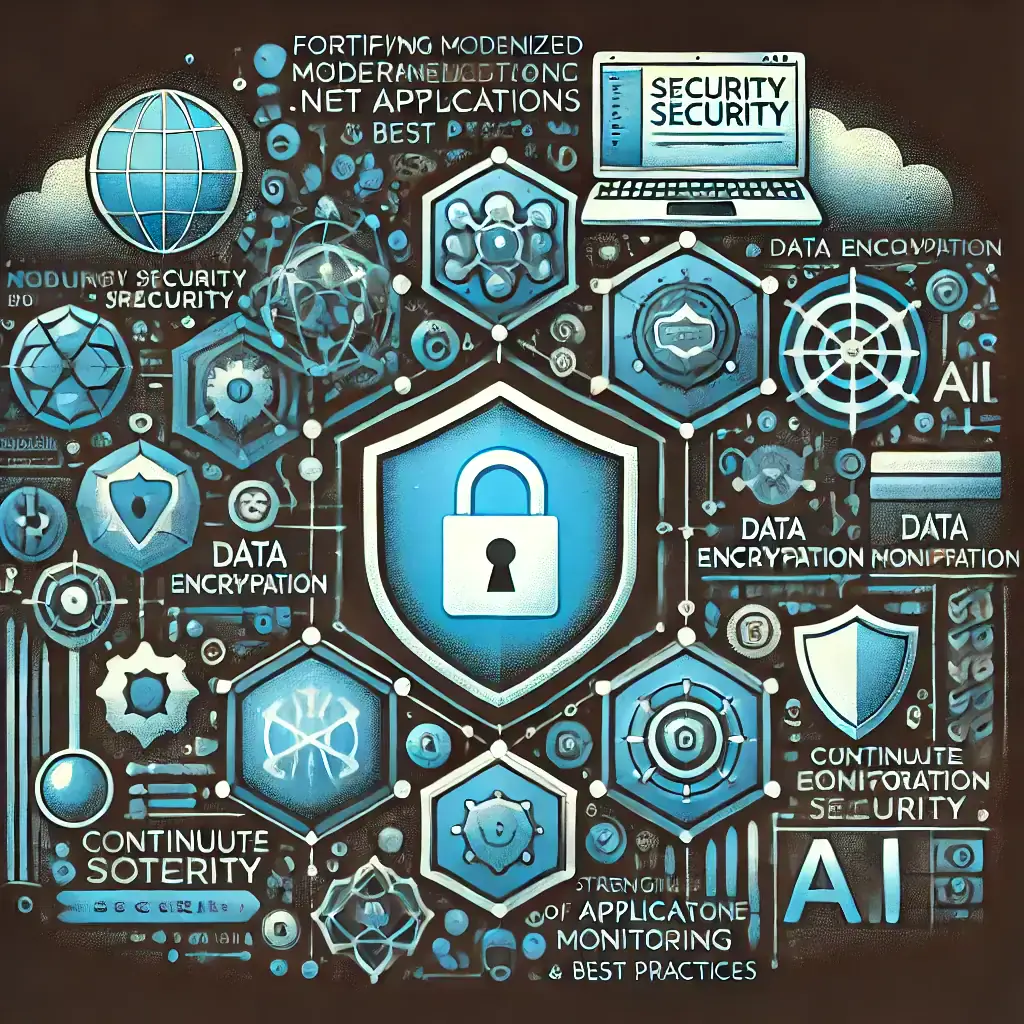· iWork Technologies Team · Product Modernization · 6 min read
Fortifying Modernized .NET Applications - Best Practices
Learn how to protect your modernized .NET applications by addressing legacy vulnerabilities, adopting modern security protocols, and leveraging AI-driven tools for continuous monitoring and threat detection.

Application and Data Security
As we continue our 11-part series on modernizing legacy .NET applications, Part 7 focuses on one of the most critical aspects of the modernization process: application and data security. As you transition your legacy systems to modern architectures, ensuring the security of both your applications and the data they handle is paramount. This post will guide you through the security challenges specific to modernization, the implementation of modern security protocols, and the importance of continuous monitoring and threat detection.
Security Challenges in Modernization: Addressing Vulnerabilities in Legacy Systems
Legacy systems often suffer from outdated security practices that make them vulnerable to modern threats. As you modernize your .NET applications, it’s essential to identify and address these vulnerabilities to protect your organization from potential breaches.
Common Security Challenges
-
Outdated Security Protocols: Legacy systems may rely on outdated security protocols that no longer meet industry standards. These protocols might be susceptible to modern attack vectors, such as man-in-the-middle (MITM) attacks or brute force attacks.
-
Unpatched Vulnerabilities: Legacy applications often have known vulnerabilities that have not been patched, either due to lack of support or oversight. These unpatched vulnerabilities can be exploited by attackers to gain unauthorized access to your systems.
-
Lack of Encryption: Older systems may lack proper encryption mechanisms, leaving sensitive data exposed to interception and unauthorized access. This is particularly concerning for data in transit and data at rest.
-
Limited Access Controls: Legacy systems may not have robust access control mechanisms, making it difficult to enforce the principle of least privilege. This can lead to excessive permissions and increased risk of insider threats.
Addressing these challenges requires a thorough security assessment of your legacy systems, followed by the implementation of modern security practices as part of the modernization effort.
Implementing Modern Security Protocols: Adopting OAuth, JWT, Encryption, and Other Security Measures
As you modernize your .NET applications, it’s crucial to adopt modern security protocols that address the vulnerabilities of legacy systems and protect your applications and data from contemporary threats.
Key Security Protocols and Measures
OAuth 2.0
OAuth 2.0 is an authorization framework that allows third-party applications to access resources on behalf of a user without exposing their credentials. It is widely used for securing APIs and is compatible with modern identity providers like Azure AD, Google, and Facebook. Benefits: OAuth 2.0 enhances security by providing token-based authentication and reducing the risk of credential exposure. It is particularly useful for applications that interact with multiple services or require delegated access.
JSON Web Tokens (JWT)
JWT is a compact, self-contained token format used for securely transmitting information between parties. JWTs are commonly used for authentication and authorization in modern web applications. Benefits: JWTs simplify the authentication process by allowing stateless sessions, reducing the need for server-side session storage. They are also signed and optionally encrypted, ensuring the integrity and confidentiality of the transmitted data. Encryption:
Data at Rest
Implement strong encryption algorithms (e.g., AES-256) to protect sensitive data stored in databases, file systems, and backups. Encrypting data at rest ensures that even if the storage medium is compromised, the data remains unreadable without the decryption key.
Data in Transit
Use Transport Layer Security (TLS) to encrypt data transmitted over networks, preventing eavesdropping and MITM attacks. Ensure that all external and internal communications are secured with TLS.
Multi-Factor Authentication (MFA)
-
Overview: MFA requires users to provide two or more forms of verification before gaining access to a system. This typically includes something the user knows (password), something the user has (security token), and something the user is (biometric verification).
-
Benefits: MFA significantly reduces the risk of unauthorized access by adding an additional layer of security beyond just a password.
Role-Based Access Control (RBAC)
- Overview: RBAC restricts system access based on the roles of individual users within an organization. Users are granted the minimum permissions necessary to perform their job functions, adhering to the principle of least privilege.
- Benefits: RBAC reduces the attack surface by limiting access to sensitive data and systems, preventing unauthorized actions and minimizing the impact of a potential breach. By implementing these modern security protocols, you can protect your modernized .NET applications from a wide range of threats, ensuring that both your application and user data remain secure.
Continuous Monitoring and Threat Detection: Using AI and Modern Tools for Proactive Security Management
In the context of modern application security, continuous monitoring and threat detection are essential for identifying and mitigating security risks in real-time. As you modernize your .NET applications, adopting AI-powered tools and practices for proactive security management can help you stay ahead of evolving threats.
Key Practices for Continuous Monitoring and Threat Detection
Security Information and Event Management (SIEM)
- Overview: SIEM solutions aggregate and analyze security-related data from across your IT environment, providing real-time visibility into potential security incidents. SIEM tools can detect patterns and anomalies that indicate malicious activity, enabling rapid response to threats.
AI Integration
Modern SIEM solutions often incorporate AI and machine learning algorithms to enhance threat detection capabilities, reducing false positives and identifying complex attack patterns that traditional methods might miss.
Intrusion Detection and Prevention Systems (IDPS)
- Overview: IDPS solutions monitor network traffic and system activities for signs of intrusions or malicious behavior. They can detect and block threats in real-time, preventing unauthorized access and damage to your systems.
- Benefits: Implementing IDPS as part of your security infrastructure helps protect against a wide range of attacks, including malware, phishing, and DDoS attacks.
Endpoint Detection and Response (EDR)
-
Overview: EDR solutions focus on monitoring and protecting endpoints (e.g., desktops, laptops, servers) from security threats. EDR tools can detect and respond to threats at the endpoint level, providing detailed insights into attack vectors and impact.
-
AI and Automation: AI-powered EDR solutions can automatically detect and respond to threats, minimizing response times and reducing the workload on security teams.
Vulnerability Management
-
Overview: Regularly scan your applications and infrastructure for vulnerabilities, using automated tools to identify and prioritize issues based on their severity. Vulnerability management tools can also provide remediation guidance to help you address security gaps effectively.
-
Continuous Patching: Implement continuous patching practices to keep your systems up to date with the latest security patches, reducing the risk of exploitation.
Security Automation and Orchestration (SOAR)
- Overview: SOAR platforms automate the process of responding to security incidents, orchestrating workflows across various security tools and systems. This reduces manual intervention and ensures a faster, more coordinated response to threats.
- AI-Powered Threat Hunting: Use AI-driven threat hunting tools to proactively search for signs of compromise within your environment, identifying and mitigating potential threats before they can cause harm.
Continuous monitoring and proactive threat detection are crucial components of a comprehensive security strategy. By leveraging modern tools and AI-powered solutions, you can enhance your ability to detect, respond to, and prevent security incidents in your modernized .NET applications.
Conclusion
As you modernize your legacy .NET applications, addressing security challenges is critical to protecting your organization’s assets and data. By implementing modern security protocols, adopting continuous monitoring practices, and utilizing AI-powered tools for threat detection, you can ensure that your modernized applications are resilient against contemporary security threats.
In the next part of this series, we will explore how to enhance user experience and interface design in your modernized applications, focusing on leveraging modern frameworks and best practices to create intuitive and user-friendly interfaces.



